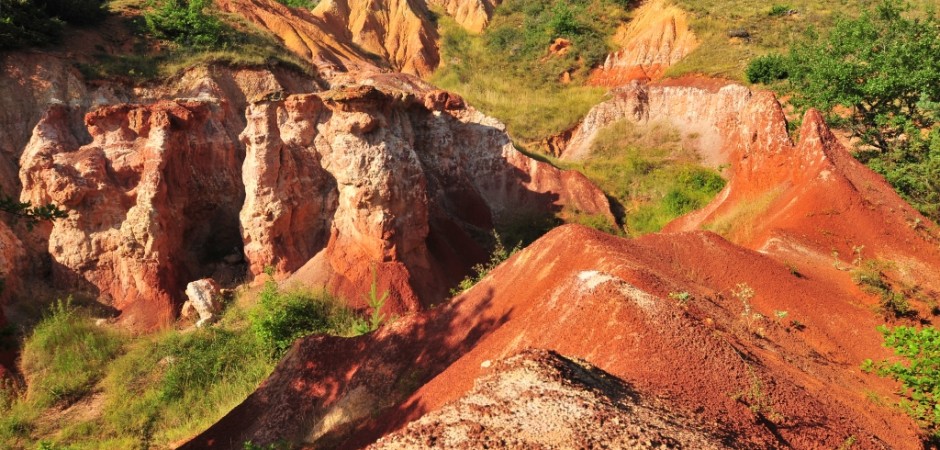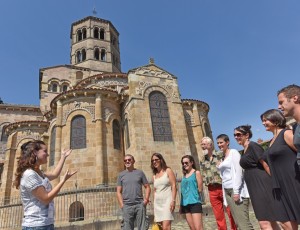In Pays d’Issoire, everything is volcanic!
From the Auvergne Volcano Regional Nature Park to the Livradois-Forez Regional Nature Park, everywhere you look there are puys (volcanic mountains), lava plugs, alluvial plains, volcanic headlands and basalt in tabular (lime) form or in vast expanses in Le Cézallier. This “volcanic” history has left behind some exceptional landmarks:
> Le Cézallier
No one is ever indifferent when seeing these vast expanses, this land so near the sky, for the first time. Here, there are no buildings, no department stores, and no traffic jams, either… In the areas between the Monts Dore and the Monts du Cantal, visitors leave all that far behind, and are captivated by immense pastures, where cows graze in peace, by villages scattered over the plateau and by the rounded shapes and bumps in the landscape that was moulded by glaciers.
To appreciate these landscapes of Cézallier, we recommend the Jassy walking hike or two tours by car, one on the theme of volcanoes, the other on the theme of water.
> The Fairy Chimneys in Saints Valley
Like the backdrop of a western, the red lands of Lembron have been sculpted by erosion to form ochre-red upright columns, recalling the silhouettes of monks in long homespun habits.
To visit this site, listed as a “Sensitive Natural Area”, the Saints Valley hike leaves from the village of Boudes and lasts about 2 hours.
> Pic du Brionnet, its basalt “organ pipes”, chapel and panorama
One of the magical sites of Pays d’Issoire… The Pic de Brionnet rises to 927 metres and looks down on the beautiful village of Saurier. On this basalt mass in the shape of a needle, the charming Notre Dame du Mont-Carmel chapel rests on columnar jointed volcanic rocks. At the top, your climb will be rewarded with a breathtaking view of the Courgoul gorges, the Massif du Sancy, the Livradois-Forez and the Puy-de-Dôme.
To visit this site, you can set off from the foot of the village for a 3-hour hike, or from the top for a 20-minute climb.
> The Upper and Lower lakes at La Godivelle in Le Cézallier
One was formed by glaciers, the other is an ancient crater. The first, the Lac d’en Bas, or Lower Lake, is part of a natural reserve, Les Sagnes de La Godivelle. It is one of the oldest reserves in France, protecting two peat bogs, one at the lakeside, and the other downstream from the village. This natural peat environment is truly fascinating to observe, since it is the home of such rare species as the round-leaved sundew, an insect-eating plant, or leopard plants. The second, the Lac d’en Haut, or Upper Lake, is circular in shape and is one of the most oligotrophic lakes (poor in nutrients) in Europe.
Between these two lakes is the small village of La Godivelle. This is the least populated village in Puy-de-Dôme (about 20 inhabitants), but also the highest in the department, since it rises to 1220 metres.
> The basalt “organ pipes” of Usson
The village of Usson, ranked as one of the Most Beautiful Villages in France, is perched up on a volcanic peak facing the Chaîne des Puys, the Massif du Sancy and Le Cézallier. Towards the peak summit, the rocky outcrops reveal basalt “organ pipes” – columnar jointed volcanic rocks – which are similar in shape to church organ pipes.
In the village, you can enjoy looking for the black stone from the “organs” which has been used to build the houses.
> The Perrier caves, village of rocks
The biggest troglodytic site in Auvergne, this “rock village” was inhabited until the 19th century. In the cliff formed by volcanic matter, people dug out as many as 300 caves. This “village” was also fortified, as can be seen by the Maurifolet tower.
Access and visits to the Perrier caves are reserved to visitors on foot, and are free of charge. You should park on the church square in the village of Perrier and walk along Rue de la Poste, then Rue des Grottes to reach the site.
There is also a 3 hour-30 minute hike, “Chaux de Pardines and Perrier caves”.
> Rocher de la Jaquette Nature Reserve
This reserve, on the slopes of the Rentières valley and on the edge of Le Cézallier volcanic plateau, was originally created to protect the Eurasian eagle-owl. But today this area is renowned for hosting such a wide diversity of environments on just a few hectares (cliffs, dry grassland, heath, forests), and contains many different species of insects. Among them are four butterflies that are protected in France (the Apollo, the Clouded Apollo, the large blue butterfly, the marsh fritillary).
> Livradois amethyst
The amethyst, or Bishop’s stone, a semi-precious stone, is a real curiosity for visitors to Pays d’Issoire. The veins found near Vernet-la-Varenne in Livradois acquired a great reputation in the Middle Ages, and were exported as far as Switzerland and Spain to make jewellery and ornaments. Today, these veins “of Auvergne amethysts”, such as in the Pégut ravine, still attract great interest, with regularly organised visits.

 UK
UK
 FR
FR














